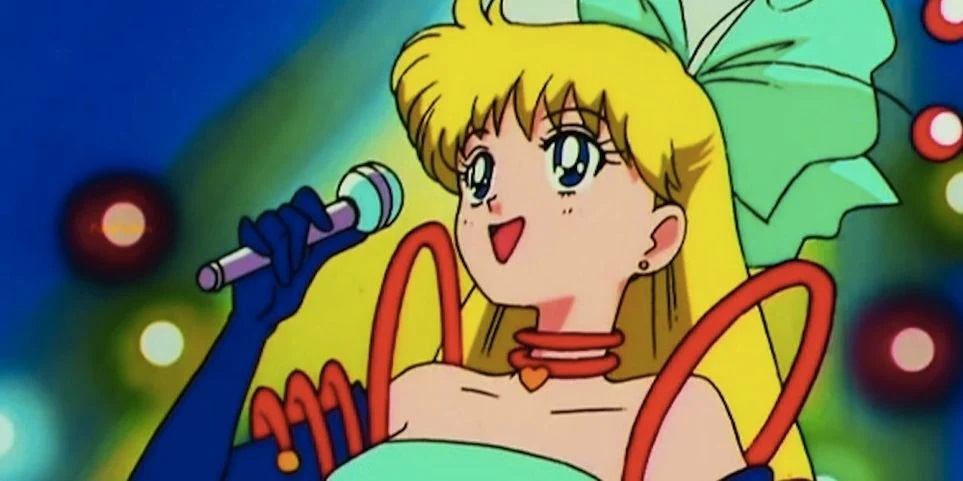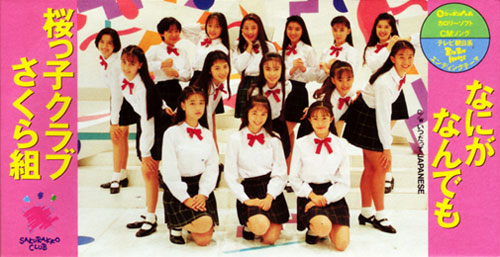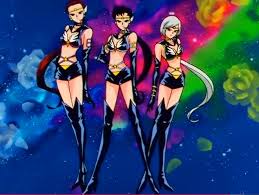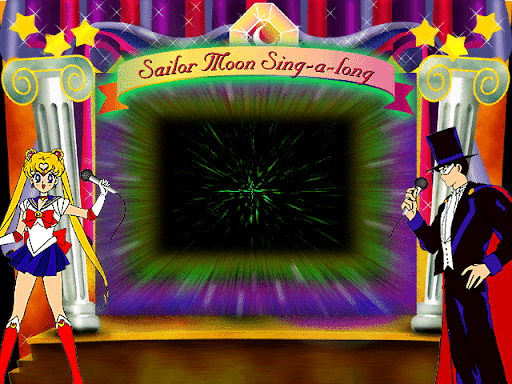While many would associate Japan’s fascination with idol groups with the meteoric rise to popularity of AKB48 and the many other groups, anime, and games that have spun off from the concept since then, Japan’s fixation on love for school-aged sweethearts actually goes back several decades.
But what does that have to do with our favorite Sailor-suited guardians of justice?
Well, as it turns out, idol culture played a pretty role in engaging fans and keeping them hooked. Today we’re going to take a look at the idols that created Sailor Moon as well as the idols the series in turn created!
Though it’s hardly a secret that Sailor Moon was initially launched with the intention of creating a mass-media blitzkrieg, what’s lesser known is all of the business partners who were pulling strings in the background to make it happen.
Sakurakko Club, a Japanese pop idol group and TV program active between 1991 and 1994 on TV Asahi,1 played a particularly influential role in getting Sailor Moon off the small screen and onto the stage while also lending their voices to some of the series’ most memorable songs.
In fact, all five of the initial SeraMyu Inner Senshi were members of the Sakurakko Club-spawned idol group, “Sakurakko Club Sakura-gumi.”
“But Jason,” I hear you scream to the gods in a desperate attempt to transmit your voice through the information superhighway, “what does that have to do with idol culture influencing Sailor Moon‘s rise to popularity?!”
Well, my ever helpful segue device, a lot actually!
Of course the Three Lights serve as a convenient low-hanging fruit in this matter, one could easily argue that it was in fact the original Sailor Team, the Inner Senshi, who were structured around the concept of an idol group.
We’ve got the five distinct personalities and character designs (for the most part) and, what’s more, they’re even sporting the ever-popular sailor school uniforms! It’s a win-win all the way around.
While Sailor Moon was by no means the originator of this kind of group dynamic, where it really excelled was in ensuring that each of the Sailor Senshi were fleshed out enough to make them a valid “favorite” character. Though some characters got more love than others at the polls, they were all wildly popular in their own right.
The fan attention garnered by each of the Sailor Senshi was so intense, in fact, that it spread to their respective voice actresses as well, eventually resulting in Kotono Mitsuishi (Usagi), Aya Hisakawa (Ami), Michie Tomizawa (Rei), Emi Shinohara (Makoto), and Rica Fukami (Minako) coming together to form their own idol group known as “Peach Hips.”
Though the “group” only actually performed on stage several times in 1993 and released no CDs of their own,2 they performed covers of a variety of Sailor Moon songs and even performed a never-rereleased Obon dance rendition of “I am Sailor Moon.”
Most notably, perhaps, is that these performances were largely a labor of love for the voice actresses. In fact, according to Kotono in a 2013 interview:3
当時は声優イベントとかも、いまみたいにバックアップ体制がない環境だったので、稽古場や衣装、そして振り付け師の手配まで、全部自分たちでやって手作り感満載でした。
Or for those who would prefer their interviews in English:
We had nothing like the kind of backstage support for seiyuu events and the like back then, so everything from the practice sessions to the costumes, and even the choreography, was all just kind of thrown together by all of us.
More specifically, these young voice actresses all came up with their own choreography together on the fly and practiced at each other’s houses.4 Pretty impressive, I must say!
So where does that leave us? Well, as per usual, the world of Sailor Moon and the circumstances surrounding it are complicated and involved a lot of moving parts.
Much can be said about how the story played with themes of love, friendship, transformation, and the “happily ever after” princess. However, as we saw with Ami’s massive popularity among the older male otaku crowd, there’s also a compelling argument to be made about how both incorporating and reinforcing the thriving idol culture into the anime also played a significant role in keeping Sailor Moon in the limelight.
After all, how many kids are actually interested in voice actresses in the first place? If you watch any of the videos of Peach Hips’ performances, you’ll notice that the audience skew s heavily toward the older male demographic — something we rarely talk about when discussing Sailor Moon.
At least that’s my take on the situation! What do you think about all this, and how much of a role do you think idol culture has played in the development of more recent anime? I’d love to hear your thoughts down below!
References:





This is a manga ? if Neo Queen has con not use her powers anymore then how does Sailor Cosmos exist?
Ask Puu, Small Lady.
Sailor Cosmos is deliberately ambiguous. We are told she is a future form of Sailor Moon but not what that means.
Neo Queen Serenity lost her powers as Sailor Moon because the Sailor Crystal of the Moon passed to Chibiusa when Chibiusa was born. Neo Queen Serenity still has the Silver Crystal. She is literally the new Queen Serenity, an immensely powerful being but not a Sailor Solider. During the manga, the Silver Crystal and the Sailor Crystal of the Moon essentially merge but must separate at some point to allow Neo Queen Serenity to still have it while also allowing Chibiusa to be Sailor Moon.
If Sailor Cosmos is supposed to be a direct future form of Usagi Tsukino, then she must gain a new Sailor Crystal to become Sailor Cosmos at some point. If Sailor Cosmos is supposed to be a future form of Sailor Moon, then the Moon’s Sailor Crystal must evolve into the Cosmos’ Sailor Crystal at some point. It’s left up to the reader to decide what this means.
Nice to see you back! I’ve found while I was in Japan that old dudes were way more into idols (I went into the AK848 store in Akihabara and was the youngest person by far at 34), which I also found horrifying, lol. That aspect always seemed to be there, which might explain the idol group having older male fans.
I can definitely see your point on idols informing the characters, with each one carefully set up personality-wise to be either identifiable or inspirational, as it were.
For those who want to hear the live audio, here’s a video of the live performance with the live audio:
https://youtu.be/ZU1MhWZLjxs
The video in the post has the CD audio on top of the live performance video. But it also has English subs, which the video I’m posting doesn’t.
I’m so glad to see you posting again! Honestly, this has become one of my favorite Sailor Moon blogs ever. I’m always eagerly awaiting new content.
Is that sing-along screencap from that “3D Adventures of Sailor Moon” PC game? That brings back memories. I had that thing, no wait, I still do, I think. I was going to sell off some of my dub merchandise, but I think I held onto that for nostalgic reasons. If nothing else, I really liked the mini music videos that they made.
(As a huge j-idol fan, I’m always happy to see idols being mentioned, even if there was barely any connection between them and the subject lol)
I’d say that idols were always present in the magical girl anime genre, like in Creamy Mami, where the magical girl becomes an idol (of course in her transformed form, so that she can still go to school etc to be relatable as a normal person). Having a cool secret identity is a popular trope, be it a magical girl or someone famous. Or, in other shows, idols get superpowers and the mostly idol themed anime gets some elements of a magical girl one.
People might not know (I guess the majority of fans haven’t seen the musicals, or haven’t researched stuff about the cast) that, over the years, the actresses casted in Sera Myu for Inner Senshi roles were usually more or less famous idols
I love idols too! I never thought of it before but my love for Sailor Moon definitely primed me and lead the way to discovering idols!
A while after my first comment here, I found your twitter site (cool stuff), and read about why you had to go on hiatus. My sincerest condolences for the hard time you went through and I hope things improve for you and your family. Sorry if this is a little personal, I just hope all of you are well.
I feel like, just for the sake of completeness, someone should mention Momoiro Clover Z…
This thing should have been told to Miss Takeuchi from the get go, since I’m currently reading the manga and it is very clear to my view that this lady, albeit being strong in the design department, had absolutely no intention to develop a coherent, fully fleshed-out world where ALL the characters, including the enemies, and not just the main three (meaning Mamoru, Usagi and Chibiusa) had engaging and relatable stories. But this is not how the american superheroes, which were an inspiration behind Sailor Moon, work. Why? because the superheroics world needs to be filled not just of the protagonist and his or her lover and an eventual son but several characters that can represent an ulterior ca$h income for the publisher. I’m not saying it with the idea of bashing the mechanism, I’m saying it in the most objective, valueless way possible. Hell, I even LOVE some characters born in this way, so there’s nothing wrong with expanding the world for a profit reason if it’s done well. Yet Miss Takeuchi could not envision that because she was SO OBSESSED about her Mary Sue and Gary Stu characters (because in the manga, NOT in the anime, that’s literally what Usagi and Mamoru are) that she could have destroyed her own income if Toei had not changed the original core material developing characters where the author could not give two shits about doing it. Which at the end of the day is a very limiting, self-castrating way of thinking.